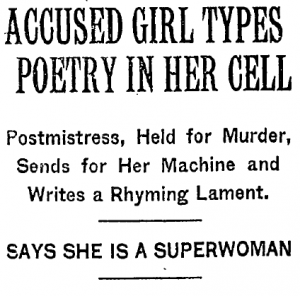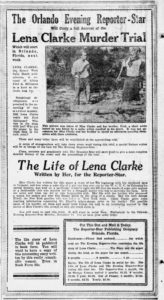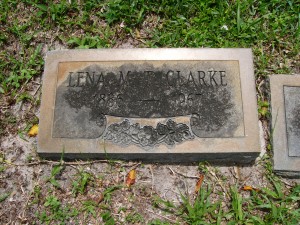Author Note: This blog posting from 2011 has been expanded into a novel., The Crystal Ball Chronicles (available here – https://a.co/d/cmnpv8E). This historical fiction book tells the complete story of Lena Clarke through the eyes of a local reporter, Kate Brennan. If you plan on reading the book, the following blog post contains spoilers!
This blog posting found its way to me in mysterious ways. I was looking for information on the Clarke family that farmed the Lake Clarke area in the old Tropical Sun newspapers online. What I found instead was a story that belies belief. My timing in finding this story also showed it to be another Orlando Florida murder trial that ended as no one expected.

Susan Clarke Warner, Lena Clarke and Maude Clarke in West Palm Beach. Photo courtesy Historical Society of Palm Beach County
Lena Marietta Thankful Clarke was by all accounts an outstanding, intelligent young woman, born in 1886. Her father, the Rev. Almon Taylor Clarke was a nationally-known theologian. Lena Clarke devoted much of her time to the Red Cross, the Congregational Church, and selling war bonds during World War I. Her sister Maude was the West Palm Beach city librarian, and sister Susan and family were the first florists in Miami. The family had lived in many states, and moved to Poinsettia Street (later Dixie Highway) in what today is the Fern Street Chess Park in front of the Alexander Loft apartments.
Lena was an intelligent and precocious child, reportedly reading philosophy books at the age of 6, according to author Stuart McIver who told of this twisted tale in his book Murder in the Tropics. Lena worked more than a decade at the West Palm Beach post office. Her brother John Paul Clarke was postmaster from 1910-1913. He met a bizarre death on Christmas Day, 1920 when he died of a Coral snake bite. Paul was a taxidermist and snake charmer, and quit the post office in 1918 due to hearing loss. After the subsequent postmaster resigned in 1920, local businessmen circulated a petition to have Lena Clarke appointed postmistress. It was quite an important job for a woman at that time.
Clarke’s life began to unravel after her brother’s death. Post offices at that time took in quite a bit of cash beyond stamp sales and mailing parcels, mostly for money orders, cash on demand, and war bonds. On July 26, 1921 Clarke sent $32,000 in cash in two registered mail sacks to the Atlanta Federal Reserve Bank for deposit from the First National Bank in West Palm Beach.
When the mail sacks arrived in Atlanta, they were filled with mail order catalogs cut to the size of currency. Authorities sent a postal inspector and questioned Clarke about the theft. On Monday, August 1, Clarke hired a driver (Baxter Patterson) to take her to Orlando. She checked into room 87 of the San Juan Hotel in downtown Orlando under an assumed name. She met up with a former mail carrier with whom she had worked and had an affair – Fred Miltimore. Miltimore, originally from Illinois, had left his post office job in West Palm Beach and was now running the Arcade restaurant in Orlando.
Later that evening a sweaty and disheveled Clarke walked into Chief E. D. Vestal’s office at the Orlando police station. She told Vestal that officers should go to the San Juan Hotel and arrest Fred Miltimore for the theft of the $32,000 he had stolen from the West Palm Beach post office. She claimed to have drugged Miltimore with a morphine pill. Vestal confirmed with West Palm Beach that she was indeed the postmistress. He sent officers out to the hotel, but they did not find a drugged Mr. Miltimore – they found a dead Mr. Miltimore, having been shot in the chest with a gun lying nearby.
With Clarke still in his office, the officers relayed the information on Miltimore’s demise back to the chief. He immediately accused Clarke of killing Miltimore. She initially denied it, but did confess – yes, she had shot him because Miltimore would blame the money theft on her. Within days, Clarke was indicted on charges of first degree murder in Orange County.
In the months before trial, her story became more sensational and her celebrity status rose. She received fan mail and flowers, and redecorated her jail cell. She even wrote an autobiography from jail which she sold through local newspapers for 25 cents. She recanted her confession and claimed to have no recollection of making it to Chief Vestal. She also took to writing poetry in her jail cell:
A Fool’s Wisdom
I told you the course you pursued was wrong
But you laughed and said women are poor, weak fools
So I hushed on my lips life’s merry song
To pray, while you all disregarded God’s rules
I knew how your castle would crash on your head,
How the flowers would turn in your hands to weeds;
I saw when you turned from the ruins and fled;
Do you think I can meet, now, your soul’s sorest needs?
You expect I will comfort you and show you how
To bring your mistakes to successes still.
You look to my cunning to save you now.
Weak fool of a woman, perhaps I will.
Of course, love will fill the bitter years;
Perhaps was too cruel of a word to say.
Angels, blot from your records my prayers and my tears.
Lest they hide them from God at the judgment day.
As the trial approached, she once again changed her story about the money. She now claimed that the money had really been stolen in 1918, and that another man, Joseph B. Elwell, loaned her $38,000 to cover the theft. No one could interview Elwell – he was dead. He had been shot dead in New York in 1920 in a murder that remains unsolved. Most of the $32,000 was recovered among her belongings and bank accounts.
Clarke’s family hired two law firms to defend her – an Orlando law firm and the West Palm Beach law firm of Chillingworth and Chillingworth. Both firms had settled on an insanity defense and Clarke did much to support their case.
As she testified in her own defense, she gazed into a crystal ball she had on the witness stand, telling of the twelve previous lives she had lived. She had lived in the Garden of Eden, had been the goddess Isis in Egypt, then Berenice, the last queen of the Jews, King Herod’s wife, and that she had been eaten by lions. Now we jump forward many centuries and she is with William Shakespeare, and that Clarke served as the role model for his Ophelia character in Hamlet. Throughout these scenes, she claims Miltimore was there, and always tormenting her in various ways.
She proclaimed that she would be found innocent and that this would be the start of her national career, serving as vice president of the United States and then president. She predicted that President Eugene V. Debs, head of the socialist party, would be assassinated, and she would then be president.
Several psychiatrists, or “alienists” as they were then called, testified as to her mental state. Two found her to be insane, while one thought the whole thing to be a clever ruse. The all-male jury recessed and came back in less than three hours with their verdict – not guilty by reason of insanity. The judge committed her to the Florida State Mental Hospital at Chattahoochee. She proclaimed to the judge that she would have rather been sent to the gallows than a mental hospital.
Alas, her stay was short at Chattahoochee, less than two years. She quietly returned to West Palm Beach and resumed her work with the church and the Red Cross. She lived in the house on Poinsettia Street with her sister Maude, with neither woman marrying. The Chillingworths held a mortgage on the house as payment for their legal services; Maude paid it off in 1966.
Clarke shows up frequently in articles with her relief efforts through the 1940s and 1950s. In later years Clarke did much writing on church history for several publications. She wrote poetry for several national and local publications under pen names. She died in 1967, and is buried in Woodlawn Cemetery in West Palm Beach next to her sister.
The echoes to an unexpected verdict from an Orange County jury after a short deliberation certainly brings to mind the 2011 Casey Anthony murder case. In 1921 the Orlando Morning Sentinel relayed that more reporters were in town to cover the Clarke trial than at any other event that had occurred in Florida. That certainly can be said of the Anthony case as well.
I think Lena Clarke took to the grave her true motivation for killing Miltimore. Was she a spurned lover? Did her mental illness finally break through? It is difficult to rationalize someone’s mind with such narcissistic and sociopathic tendencies. Mental health was a less understood illness in the 1920s, but Clarke’s demons went untreated.
This story was researched through the New York Times, the Tropical Sun, the Historical Society of Palm Beach County, the Palm Beach Post archives, and the book by Stuart McIver, Murder in the Tropics.









Now that is truly a wacky story. Truth is stranger than fiction.
[WORDPRESS HASHCASH] The poster sent us ‘0 which is not a hashcash value.
Very interesting true story.